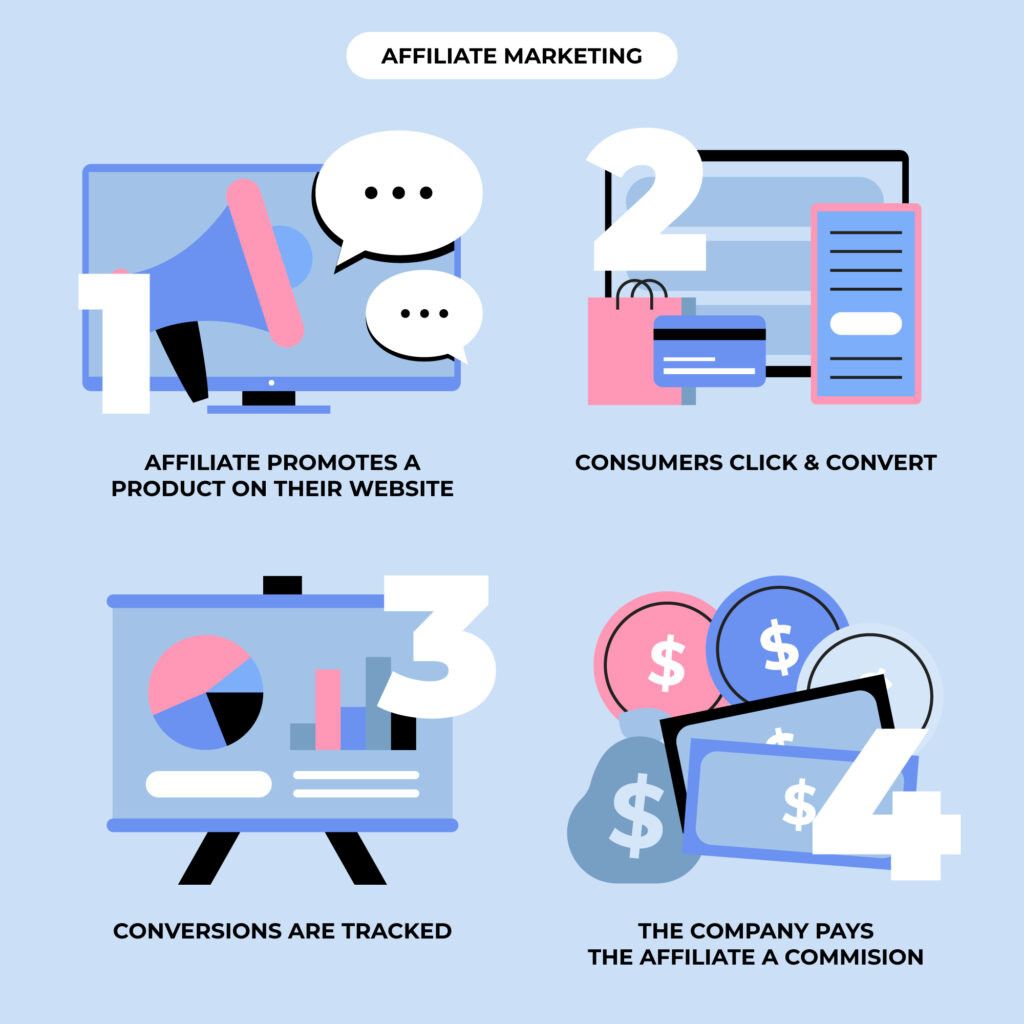The Basics of Affiliate Marketing: A Beginner’s Guide
Affiliate marketing is a powerful and popular online business model that has transformed the way businesses promote their products and services. It has also become an attractive opportunity for individuals looking to earn money online. If you’re new to the world of affiliate marketing, this comprehensive beginner’s guide will provide you with a solid understanding of the concept, its benefits, and how it works for both affiliates and advertisers.
What is Affiliate Marketing?
At its core, affiliate marketing is a performance-based marketing strategy where affiliates (also known as publishers or partners) promote products or services of other companies and earn a commission for each sale or action generated through their promotional efforts. Affiliates act as intermediaries, connecting consumers with the products or services they need, and in return, they receive a share of the revenue they help generate.

How Does Affiliate Marketing Work?
- The Merchant (Advertiser):
- The merchant is the business or company that owns the product or service being promoted.
- They create an affiliate program and provide affiliates with unique tracking links or affiliate IDs to monitor their referrals’ performance.
- The Affiliate (Publisher):
- The affiliate is the individual or entity promoting the merchant’s products or services on their website, blog, social media, or other marketing channels.
- They earn a commission for each sale, lead, or action generated through their affiliate links.
- The Consumer:
- The consumer is the end-user who clicks on the affiliate’s unique link and makes a purchase or completes the desired action on the merchant’s website.
- The consumer doesn’t pay anything extra; the commission comes from the merchant’s marketing budget.
- The Affiliate Network or Platform:
- Many affiliate programs are managed through affiliate networks or platforms.
- These networks facilitate tracking, reporting, and payments between the merchant and affiliates, making the process more streamlined.
Learn more: Affiliate Marketing Glossary
What are the Benefits of Affiliate Marketing?
Affiliate marketing offers numerous benefits for all parties involved:
- For Affiliates:
- Opportunity to earn passive income from their website or social media presence.
- Flexibility to choose products or services that align with their niche and audience.
- No need to create or maintain products; the merchant handles inventory and customer support.
- For Merchants:
- Cost-effective marketing strategy; they only pay for actual results.
- Access to a vast network of affiliates with diverse audiences and marketing expertise.
- Increased brand exposure and reach through affiliates’ promotional efforts.
How does affiliate marketing work?
Once you become a part of an Awin affiliate program, you gain access to a unique affiliate link that comes equipped with a tracking ID. This tracking ID enables the merchant to monitor and attribute any customers you refer to them.
Let’s take a closer look at the anatomy of an Awin affiliate link: https://awin1.com/cread.php?awinmid=7437&awinaffid=671819&platform=dl&ued=https%3A%2F%2Fwww.tiqets.com%2Fen%2Flouvre-museum-tickets-l124297
When someone clicks on your Awin affiliate link, a tiny file known as a cookie is stored on their device. This cookie generally comes with an expiry date, ensuring that you still receive credit for the sale even if the customer delays their purchase.
Here’s a practical example of how the process unfolds:
- A user visits your post about Le Louvre Museum in Paris
- Interested, they click on the Awin affiliate link that you inserted in your call to action.
- They are redirected to the website Tiqets.com and add to the basket two entrance tickets for this venue but decide not to process the payment
- The next day, they return to the website to revisit the product.
- Ultimately, they decide to make the purchase, not only buying the two basic entrance tickets but also adding an audio guide to their cart.
Thanks to the magic of the affiliate cookie stored on their device, you earn a commission not only on the basic entrance tickets they initially considered but also on the additional audio guide they decided to purchase. This is the beauty of Awin’s affiliate marketing, where your efforts are rewarded beyond the initial referral, making it a lucrative opportunity to capitalize on.
How to get started with affiliate marketing?
The Beginner’s Guide to Launching an Affiliate Marketing Site
Affiliate marketing is a great way to earn income online, but getting started can seem daunting. Here is a step-by-step guide to launching your own affiliate site from scratch:
Step 1: Choose a Niche

First, pick a specific niche or industry that you’re genuinely interested in and knowledgeable about. This makes it easier to create in-depth, valuable content. Research potential affiliate programs within your niche as well to ensure there are options available before moving forward.
The below categorization may help you in your decision
- Finance & Insurance = High-paying, low-volume (Niche products with fewer buyers)
- Retail & Shopping = High-paying, high-volume (Expensive products with mass appeal)
- Technology & Electronics = High-paying, high-volume (Expensive products with mass appeal)
- Travel & Tourism = High-paying, high-volume (Expensive products with mass appeal)
- Telcos & Services = Low-paying, high-volume (Products with mass appeal)
- Fashion & Apparel = Low-paying, high-volume (Products with mass appeal)
- Home & Lifestyle = Low-paying, high-volume (Products with mass appeal)
- Entertainment & Media = Low-paying, high-volume (Products with mass appeal)
- Health & Wellness = Low-paying, high-volume (Products with mass appeal)
- Digital Services = Low-paying, high-volume (Products with mass appeal)
Step 2: Select a Content Platform

Next, determine the platform you’ll use to publish your affiliate content. For those starting out, bloggers are often the best option, as they have the flexibility to create high-quality and in-depth content tailored to their niche. A well-crafted blog allows you to provide valuable information, product reviews, and recommendations to your audience. Additionally, you can leverage social media platforms to share your blog posts and reach a wider audience. Consider the costs, features, and your own skills when selecting a platform. WordPress and Blogger are popular options for blogging, offering user-friendly interfaces and a range of customization possibilities to make your affiliate marketing journey a success.
Step 3: Find Relevant Affiliate Programs

Search for affiliate programs related to your niche and sign up for ones that offer good commission rates, reputable brands, and products your audience will be interested in. Look for programs from individual merchants like Amazon Associates as well as broader affiliate networks like Awin, Rakuten ou Impact.
Learn more: Top 8 Affiliate Networks
Step 4: Create Valuable Content

Consistently publish high-quality content related to your niche that provides real value for readers. For example, write comprehensive buying guides, top product reviews, insightful tutorials, and other content that attracts and engages your target audience.
Learn more: Creating High-Converting Content For Affiliate Marketing
Step 5: Drive Traffic to Your Site

Employ a mix of organic and paid strategies to drive traffic to your affiliate site. While paid advertising can be effective in reaching a broader audience, it can also be risky to start straight away without a guarantee that your content will convert. For newcomers to affiliate marketing, it is advisable to focus on building organic traffic first. Create search engine optimized blog posts and promote your content on social media to attract visitors naturally.
By waiting at least 6 months and observing visitors’ behavior, you can gain valuable insights into your audience and refine your content and promotional strategies accordingly. Once you have a better understanding of your target audience, you can then consider incorporating paid ads through platforms like Google, Facebook, native networks, etc., to further boost your affiliate marketing efforts. Collaborating with other sites in your niche can also be a fruitful way to expand your reach and drive traffic to your affiliate site.
Step 6: Get Clicks on Affiliate Links

Once you begin attracting a steady stream of visitors, focus on naturally incorporating relevant affiliate links into content to earn commissions.
A. Link Placement: Strategically place your affiliate links within your content. Avoid burying them at the bottom, where readers rarely scroll. Conversely, avoid overloading your introduction with too many links, as it can make your content appear spammy. Strike a balance between link placement and other crucial elements.
B. Provide context and value around recommendations rather than just links. For example, make sure the links naturally fit within the discussion the specific products you promote. Lastly, disclose clearly affiliate relationships.
With the right preparation, strategic approach, and commitment to creating high-quality affiliate content, you can build a successful affiliate marketing site that earns you income over the long-term.





